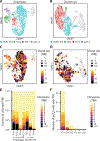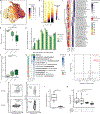Clonally expanded, GPR15-expressing pathogenic effector TH2 cells are associated with eosinophilic esophagitis
- PMID: 34389613
- PMCID: PMC8686696
- DOI: 10.1126/sciimmunol.abi5586
Clonally expanded, GPR15-expressing pathogenic effector TH2 cells are associated with eosinophilic esophagitis
Abstract
Eosinophilic esophagitis (EoE) is an allergic disorder characterized by the recruitment of eosinophils to the esophagus, resulting in chronic inflammation. We sought to understand the cellular populations present in tissue biopsies of patients with EoE and to determine how these populations are altered between active disease and remission. To this end, we analyzed cells obtained from esophageal biopsies, duodenal biopsies, and peripheral blood of patients with EoE diagnosed with active disease or remission with single-cell RNA and T cell receptor (TCR) sequencing. Pathogenic effector TH2 (peTH2) cells present in the esophageal biopsies of patients with active disease expressed distinct gene signatures associated with the synthesis of eicosanoids. The esophageal tissue-resident peTH2 population also exhibited clonal expansion, suggesting antigen-specific activation. Peripheral CRTH2+CD161- and CRTH2+CD161+ memory CD4+ T cells were enriched for either a conventional TH2 phenotype or a peTH2 phenotype, respectively. These cells also exhibited substantial clonal expansion and convergence of TCR sequences, suggesting that they are expanded in response to a defined set of antigens. The esophagus-homing receptor GPR15 was up-regulated by peripheral peTH2 clonotypes that were also detected in the esophagus. Finally, GPR15+ peTH2 cells were enriched among milk-reactive CD4+ T cells in patients with milk-triggered disease, suggesting that these cells are an expanded, food antigen-specific population with enhanced esophagus homing potential.
Copyright © 2021 The Authors, some rights reserved; exclusive licensee American Association for the Advancement of Science. No claim to original U.S. Government Works.
Conflict of interest statement
Figures







Comment in
-
Zooming in on T cell clones: Are we heading to personalized treatment of allergy?Sci Immunol. 2021 Aug 13;6(62):eabj1366. doi: 10.1126/sciimmunol.abj1366. Sci Immunol. 2021. PMID: 34389614
Similar articles
-
Distinct CRTH2+CD161+ (peTh2) memory CD4+ T-cell cytokine profiles in food allergy and eosinophilic gastrointestinal disorders.Clin Exp Allergy. 2023 Oct;53(10):1031-1040. doi: 10.1111/cea.14376. Epub 2023 Jul 24. Clin Exp Allergy. 2023. PMID: 37487654 Free PMC article.
-
Elevated expression of activated TH2 cells and milk-specific TH2 cells in milk-induced eosinophilic esophagitis.Ann Allergy Asthma Immunol. 2018 Feb;120(2):177-183.e2. doi: 10.1016/j.anai.2017.11.006. Epub 2017 Dec 28. Ann Allergy Asthma Immunol. 2018. PMID: 29289462 Free PMC article.
-
Invariant natural killer T cells in children with eosinophilic esophagitis.Clin Exp Allergy. 2014 Jan;44(1):58-68. doi: 10.1111/cea.12201. Clin Exp Allergy. 2014. PMID: 24118614 Free PMC article.
-
Eosinophils in Eosinophilic Esophagitis: The Road to Fibrostenosis is Paved With Good Intentions.Front Immunol. 2020 Dec 1;11:603295. doi: 10.3389/fimmu.2020.603295. eCollection 2020. Front Immunol. 2020. PMID: 33335531 Free PMC article. Review.
-
Eosinophilic esophagitis: updates on key unanswered questions.Ann N Y Acad Sci. 2020 Dec;1481(1):30-42. doi: 10.1111/nyas.14421. Epub 2020 Aug 6. Ann N Y Acad Sci. 2020. PMID: 32762154 Review.
Cited by
-
Antigen-specificity measurements are the key to understanding T cell responses.Front Immunol. 2023 Apr 14;14:1127470. doi: 10.3389/fimmu.2023.1127470. eCollection 2023. Front Immunol. 2023. PMID: 37122719 Free PMC article. Review.
-
Scientific journey to the first FDA-approved drug for eosinophilic esophagitis.J Allergy Clin Immunol. 2022 Dec;150(6):1325-1332. doi: 10.1016/j.jaci.2022.09.027. Epub 2022 Oct 6. J Allergy Clin Immunol. 2022. PMID: 36209816 Free PMC article.
-
Th2A cells: The pathogenic players in allergic diseases.Front Immunol. 2022 Aug 8;13:916778. doi: 10.3389/fimmu.2022.916778. eCollection 2022. Front Immunol. 2022. PMID: 36003397 Free PMC article. Review.
-
Granzyme K+CD8+ T cells interact with fibroblasts to promote neutrophilic inflammation in nasal polyps.Nat Commun. 2024 Nov 29;15(1):10413. doi: 10.1038/s41467-024-54685-1. Nat Commun. 2024. PMID: 39614076 Free PMC article.
-
TCF1-LEF1 co-expression identifies a multipotent progenitor cell (TH2-MPP) across human allergic diseases.Nat Immunol. 2024 May;25(5):902-915. doi: 10.1038/s41590-024-01803-2. Epub 2024 Apr 8. Nat Immunol. 2024. PMID: 38589618 Free PMC article.
References
-
- Gonsalves N, Yang GY, Doerfler B, Ritz S, Ditto AM, Hirano I, Elimination diet effectively treats eosinophilic esophagitis in adults; Food reintroduction identifies causative factors. Gastroenterology. 142, 1451–1459.e1 (2012). - PubMed
Publication types
MeSH terms
Substances
Grants and funding
LinkOut - more resources
Full Text Sources
Other Literature Sources
Medical
Molecular Biology Databases
Research Materials

